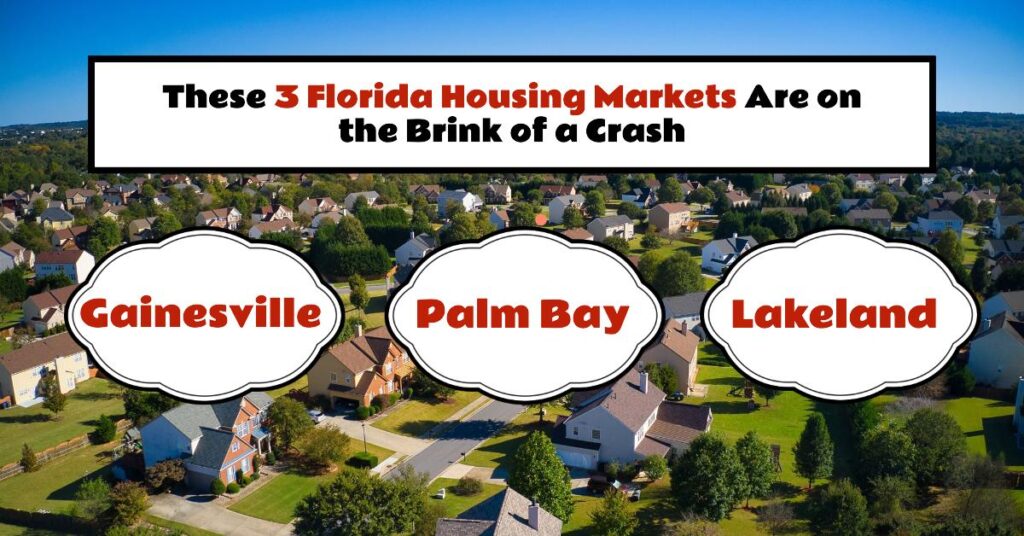As the U.S. housing market continues its precarious dance with economic forces, Florida finds itself at the epicenter of a potential real estate upheaval. Recent data from CoreLogic’s Market Risk Index (MRI) reveals an alarming trend: Florida’s three metropolitan areas are at the highest risk of experiencing significant home price declines over the next 12 months. This article explores the drivers of this impending crisis and what it means for homeowners, buyers, and investors in these vulnerable markets.
3 Florida housing market on the verge of collapse
Gainesville, FL Palm Bay, FL – Melbourne – Titusville, FL Lakeland – Winter Haven
These three metropolitan areas are said to have a “very high” risk of price declines, with a probability of over 70%. Let’s take a closer look at each market.
1. Gainesville: An educational hub on shaky ground
Gainesville, home to the University of Florida, has long been considered a stable real estate market due to the constant influx of students and faculty. However, it now ranks at the top of the list of markets at risk of falling prices. Several factors contribute to this unstable situation.
Overreliance on the student housing market Changes in distance learning may impact local demand Overvaluation of real estate in recent years
The combination of these factors has created a perfect storm for Gainesville’s housing market, making it vulnerable to a significant correction.
2. Palm Bay, Melbourne, Titusville: Economic uncertainty on the Space Coast
Known as the Space Coast due to its proximity to Cape Canaveral, the region has experienced significant growth in recent years due to a resurgence in the space industry and technology sector. However, the market is currently facing challenges such as:
Possible reductions in aerospace and defense spending Market overheating due to speculative buying Vulnerability to climate change and rising insurance costs
These factors place the Palm Bay, Melbourne and Titusville area in a high risk category for price declines, threatening the assets of recent buyers and long-term residents alike.
3. Lakeland-Winter Haven: Central Florida’s overextended market.
Located between Tampa and Orlando, Lakeland Winter Haven has benefited from its strategic location and relatively affordable housing compared to larger neighborhoods. However, this market currently faces its own set of challenges.
Rapid price increases that exceed local wage increases Dependence on the tourism and service industries, which are affected by economic fluctuations Inventory increases as investors begin to sell real estate
The combination of these factors places Lakeland Winter Haven at risk of a significant market correction.
Source: CoreLogic
understand the broader context
To fully understand these Florida market conditions, it is important to consider national housing market trends.
Nationwide housing prices in July 2024 will increase by 4.3% compared to the previous year Monthly housing price growth will slow down, with prices decreasing by 0.01% from June to July 2024 CoreLogic will We forecast a modest price increase of 2.2% in
“Housing demand remains weak under pressure from high mortgage rates and unaffordable home prices, which significantly slowed summer home price growth,” said Dr. Thelma Hepp, Chief Economist at CoreLogic. I am doing it.
florida paradox
What’s interesting is that while these three markets in Florida are at high risk of going down, the Miami market is an anomaly. With prices up 9.1% year-over-year as of July 2024, Miami illustrates the diverse and complex nature of Florida’s real estate environment.
Factors contributing to Florida’s fragile housing market
Sensitivity to Interest Rates: Florida’s real estate market is particularly sensitive to interest rate changes, impacting both local buyers and out-of-state investors. Concerns about climate change: Increasing awareness of climate risks such as hurricanes and flooding is impacting long-term asset values and insurance costs. Demographic changes: Changing domestic and international migration patterns are reshaping demand in Florida’s various markets. Economic diversity: Markets that are highly dependent on specific industries (tourism, education, etc.) are more vulnerable to economic shocks. Investor Activity: High investor ownership in Florida makes certain markets susceptible to rapid selling during economic downturns.
Impact on stakeholders
Homeowners: Those living in high-risk areas should consider long-term housing planning to protect against potential capital losses. Buyers: While falling prices may present opportunities, buyers should be cautious and consider the long-term stability of their chosen markets. Investors: Diversification and thorough market research are essential to navigating Florida’s diverse real estate landscape. Local governments: Policymakers may need to prepare for potential declines in property tax revenues and implement strategies to maintain community stability.
Looking to the future
While the risk of price declines in these Florida markets is significant, it is important to remember that real estate is local and cyclical in nature. The potential for Federal Reserve rate cuts and the natural resilience of Florida’s economy could alleviate some of these risks.
Dr. Hepp said the key question is, in the face of economic uncertainty and the upcoming presidential election, “will future rate cuts by the Fed and the expected continued decline in mortgage rates incentivize potential homebuyers?” It suggests that the question is whether it is sufficient.
As Florida’s housing market navigates these turbulent waters, stakeholders must stay informed, adapt, and prepare for a variety of potential outcomes. While the Sunshine State’s real estate market has shown resilience in the past, a number of factors are currently converging to create a unique and challenging environment for the coming months.



